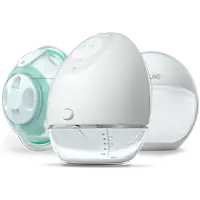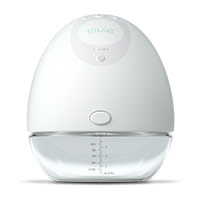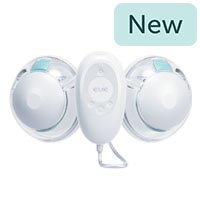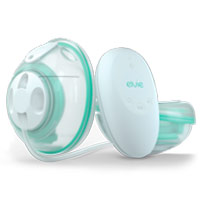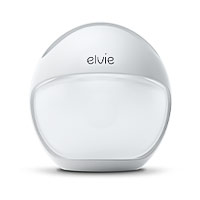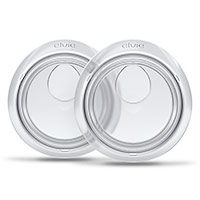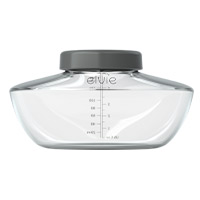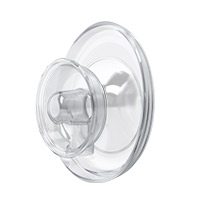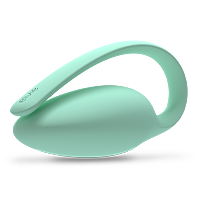This article was reviewed by lactation consultant Olivia Hinge on 02/12/24.
What is a milk duct, anyway?
“Unclogging a duct.”
The phrase might conjure images more suited to plumbing than breastfeeding. Yet, anatomically speaking, it is important to understand that a milk duct cannot become plugged in the literal sense (unlike your bathroom sink!) Milk ducts, also known as breast ducts, are slender tubes that transport milk from the glandular tissue (lobules) to the nipples. If these ducts get compressed by inflammation in the breast tissue they can get backed up with milk, resulting in what we call a blocked milk duct.
Blocked milk ducts are a common challenge among breastfeeding moms, a 2011 study found that 4.5 per cent of women experienced clogged breastmilk ducts at some point during their first year of feeding. Before we get into the do's and don'ts of blocked ducts, it’s good to ask what a breastmilk duct even does, and why it is so important throughout your breastfeeding journey.
Your ducts are the tiny tubes that carry milk from the glands deep in your breast, all the way to your nipple. We can compare them to a bunch of grapes: Imagine the grapes as the mammery gland where milk is produced, and the grape stems as the milk ducts. Muscle cells around the mammery gland contract to push milk through these ducts, creating a steady flow to your nipple during feeding. When your baby is latched on and feeding, the movements of your baby’s jaws, gums, and tongue help to pull the milk through these ducts and out the nipple. Your let-down reflex is also something that helps your milk flow through the milk ducts, and out to your waiting baby.
These magical little milk ducts play a massive role in the delivery of breastmilk to your child – but the downside is that they can also be a source of some frustrating breast problems.
What causes a clogged milk duct?
As we said, blocked ducts aren’t uncommon, and the root cause is internal inflammation within the breast, which can be caused by hyperlactation. There may be several reasons for this oversupply, it may be because your baby is missing feeds, the period between feeding or pumping sessions is too long, or your little one is struggling to latch properly and therefore isn’t draining your breast of milk at each feed.
Identifying a clogged duct early on is key to avoiding it progressing into a more serious infection named mastitis, a condition that can require a doctor's appointment and a course of antibiotics to treat.
Recognizing a clogged milk duct
Late-night feeding sessions, engorgement, leaking… chances are, you know all about the joys of breastfeeding your baby. (And yes, you’ll know all about the incredible and sweet moments too!).
Then one day, you feel a hard, wedge-shaped lump. What’s this? Well, it’s the quintessential sign of a clogged breastmilk duct. But don’t worry just yet – these things can typically be cleared at home and can get you back into your normal routine.
Symptoms can come on slowly and they generally affect just one breast.
You might experience:
A hard, hot, wedge-shaped lump in your breast tissue
Pain or swelling near the lump
Discomfort that subsides after feeding/pumping
Milk plug/blister (bleb) at the opening of your nipple
It’s also typical to see a temporary decrease in your supply when you have a clog.
Managing your clog
Stop, drop, and roll. No, seriously. The sooner you identify a clogged duct, you can get to work on treating the issue. As there is potential for a clogged duct to progress into something more serious such as mastitis, we do recommend coming up with a management plan that’s monitored by a lactation consultant or a healthcare professional.
One of the recommended treatments is to use lymphatic massage techniques. To do this, use gentle strokes towards your collarbone and armpit, in the direction of your nipple, while your baby is feeding. This can soothe the inflammation of the breast tissue and encourage the movement of milk from the blocked area. It is essential to use the correct technique when massaging the affected breast to avoid overstimulation of the milk ducts, which can prolong your symptoms and maintain a cycle of oversupply.
Here are some other expert-backed tips to soothe the inflammation causing the clog:
Continue to breastfeed as usual – If this isn’t possible, we recommend our hands-free breast pump, Elvie Pump, to relieve your milk-filled breasts. The goal here is to continue with your regular feeding schedule. Avoid adding extra feeds or pump sessions to try and clear the clogged duct as this can actually have the opposite effect and trigger an oversupply of milk. (which is what we don't want!)
Start your feeding sessions with the affected breast, to ensure it gets the most attention from baby.
Consider using an ice compress or resting your breast in a bowl of cold water to soothe the inflammation.
Trying different feeding positions can help clear the blockage. Sometimes, moving around allows your baby’s suction during feeding to better reach the blocked duct.
Take some over-the-counter anti-inflammatory painkillers to help with painful symptoms and address the inflammation.
If the blocked milk duct is not cleared after 24-48 hours, or if you start to develop flu-like symptoms, you should get in touch with your doctor to prevent the clogged duct from developing into mastitis.
Help to latch on to
We get it. Blocked milk ducts can be uncomfortable and frustrating to deal with – but keep at it. Treating it at home should be able to clear the inflammation without developing an infection or requiring further intervention. Taking active steps in prevention can also be a big bonus for your breastfeeding journey. The best way to do this is by reviewing what could cause the inflammation within the breast tissue to avoid it developing into a clogged duct.
We know it might seem impossible – especially with a newborn baby – but take care of yourself as much as possible to help prevent issues like blocked breastmilk ducts. After all, self-care isn’t a luxury!
Sneak in some cheeky naps, ask for help, or get an early night – even if you know you’ll be awake for a feeding session a few hours later. In general, just practice all the self-care you need to help you avoid feeling run-down.
If you’d like ongoing support from a third party, Unicef’s ‘Baby Friendly Initiative’ has plenty of organisations and resources to get you started. Here are just a few other mother-support groups:
References
Breastfeeding Medicine Protocol Committee. ABM Clinical Protocol #36: The Mastitis Spectrum [Internet]. Breastfeeding Medicine; 2021 [cited 2024 Feb 12]. Available from: https://www.bfmed.org/assets/ABM%20Protocol%20%2336.pdf
Cleveland Clinic. Breast Anatomy [Internet]. Cleveland Clinic; 2021 [cited 2024 Feb 12]. Available from: https://my.clevelandclinic.org/health/articles/8330-breast-anatomy
Lawrence RA, Lawrence RM. Breastfeeding: A Guide for the Medical Professional [Internet]. 8th ed. Elsevier Health Sciences; 2015 [cited 2024 Feb 12]. Available from: https://www.sciencedirect.com/science/article/abs/pii/S0884217515307668
BabyCentre UK. How breasts produce milk in pregnancy and beyond [Internet]. BabyCentre UK; 2021 [cited 2024 Feb 12]. Available from: https://www.babycentre.co.uk/a8785/how-breasts-produce-milk-in-pregnancy-and-beyond
Verywell Family. What is a Breastfeeding Latch? [Internet]. Verywell Family; 2021 [cited 2024 Feb 12]. Available from: https://www.verywellfamily.com/what-is-a-breastfeeding-latch-431642
Cleveland Clinic. Breastfeeding [Internet]. Cleveland Clinic; 2021 [cited 2024 Feb 12]. Available from: https://my.clevelandclinic.org/health/articles/5182-breastfeeding
Cleveland Clinic. Hyperlactation [Internet]. Cleveland Clinic; 2021 [cited 2024 Feb 12]. Available from: https://my.clevelandclinic.org/health/diseases/hyperlactation
Cleveland Clinic. Breastfeeding Latch [Internet]. Cleveland Clinic; 2021 [cited 2024 Feb 12]. Available from: https://my.clevelandclinic.org/health/articles/breastfeeding-latch
Cleveland Clinic. Mastitis [Internet]. Cleveland Clinic; 2021 [cited 2024 Feb 12]. Available from: https://my.clevelandclinic.org/health/diseases/15613-mastitis
Cleveland Clinic. Breast Engorgement [Internet]. Cleveland Clinic; 2021 [cited 2024 Feb 12]. Available from: https://my.clevelandclinic.org/health/diseases/breast-engorgement
Cleveland Clinic. Milk Bleb [Internet]. Cleveland Clinic; 2021 [cited 2024 Feb 12]. Available from: https://my.clevelandclinic.org/health/symptoms/milk-bleb
Cleveland Clinic. Lactation Consultant [Internet]. Cleveland Clinic; 2021 [cited 2024 Feb 12]. Available from: https://my.clevelandclinic.org/health/articles/22106-lactation-consultant
Physician's Guide to Breastfeeding. Breastfeeding and Massage [Internet]. Physician's Guide to Breastfeeding; 2021 [cited 2024 Feb 12]. Available from: https://physicianguidetobreastfeeding.org/mythbusters/breastfeeding-and-massage/
Cleveland Clinic. Non-Steroidal Anti-Inflammatory Medicines (NSAIDs) [Internet]. Cleveland Clinic; 2021 [cited 2024 Feb 12]. Available from: https://my.clevelandclinic.org/health/treatments/11086-non-steroidal-anti-inflammatory-medicines-nsaids

